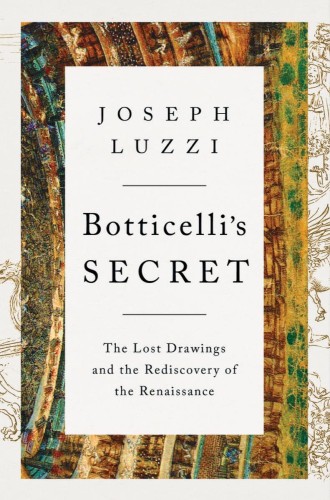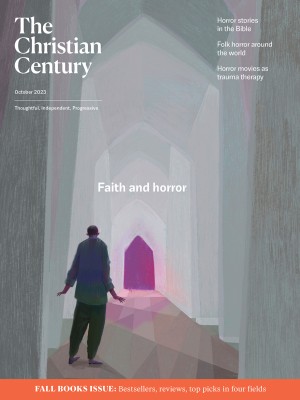Seeing Dante with Botticelli’s eyes
Joseph Luzzi tells the rich, entertaining story of the Renaissance artist’s renderings of a quintessentially medieval text.
Joseph Luzzi, who teaches comparative literature at Bard College, has a gift not only for writing scholarly books that engage big cultural topics (Romantic Europe and the Ghost of Italy, A Cinema of Poetry) but also for producing intimate memoirs (In a Dark Wood, My Two Italies). He is versatile in other ways as well. An accomplished academic, he also has wide popular appeal: he hosts a virtual book club, writes New York Times articles, and captivates TEDx watchers with his enthusiastic lecture “How Literature Can Change Your Life.” Engaged and engaging, communicating in lively prose, Luzzi knows how to tell a good story.
These qualities are on display most recently in Botticelli’s Secret. The secret at stake here is a set of drawings made by Sandro Botticelli for a Medici patron in late 15th-century Florence—a commission meant to illustrate all 100 cantos of Dante’s intensely Christian early 14th-century Commedia by a painter best known (then and now) for more secular projects, like Primavera and The Birth of Venus. What a Renaissance artist made of a quintessentially medieval text brings Luzzi to ponder all that was entailed in the seismic cultural rebirth that took place in Florence 500 years ago and has been reinterpreted again and again across the reaches of the Western world.
Read our latest issue or browse back issues.
The sweeping panorama Luzzi unfolds stretches from the 14th century to the present day, from the workshops of Florence, where art was made, to the bunkers and salt mines of wartime Germany, where it was meant to be preserved. To populate these spaces, Luzzi brings to life a varied cast of characters: poets and painters, aristocratic patrons, connoisseurs and collectors, historians and critics, charismatic religious leaders like Savonarola, and political figures ranging from Medici princes to Adolf Hitler. Luzzi has an eye for the roller-coaster ride of literary trends and shifts in taste. In the mid-18th century, for instance, Voltaire could proclaim the unthinkable: “Nobody reads Dante anymore.”
Luzzi pays special attention, of course, to Dante (d. 1321) and Botticelli (d. 1510), masters of text and image. But he also writes about those who played major parts in the rediscovery of the two throughout the 19th and early 20th centuries. Some of these include Jacob Burckhardt, the English Pre-Raphaelites, John Ruskin, Walter Pater, Bernard Berenson, and Isabella Stewart Gardner. In this crowded roll call, Luzzi also gives due attention to the Austro-Hungarian prints connoisseur Friedrich Lippmann. On an 1882 acquisition mission to London on behalf of the newly founded Royal Museum in Berlin, Lippmann came upon the proverbial gold mine: a collection of Dante texts and drawings that had been largely lost sight of for centuries. He recognized that this was quite possibly, in Luzzi’s words, “one of the most valuable and beautiful books ever produced, a sublime testament to Botticelli’s sublime hand.”
How this body of work, which quietly occupied Botticelli on and off for 15 years (1480–1495), eventually found its way to a London shop—and ended up being several drawings short of the full number commissioned—is a complicated tale that defies easy summary. Against the odds, Luzzi does his best to tell clearly the complex hide-and-seek, lost and found of it all.
Given the skillful buildup, it is a disappointment that Luzzi pays little attention to individual images (apart from the uniquely colored map of hell whose “aura” transfixes the author for a golden 15 minutes in the Vatican Museums, as recounted in his charming epilogue). The few images in the book are not of adequate size or quality for much to be seen in them. I would have liked Luzzi to give at least some of them a proper “read,” to linger more with the gorgeous lightness (leggiadria) of their being, in order to be convinced of the claims he makes about them.
That said, what matters most to Luzzi is what he takes to be Botticelli’s transformative interpretation of the poet’s text: “Dante’s austere Christian vision could somehow be translated into a new worldly key, a vision that celebrated earthly life rather than looking past or through it. The dance of the angels could take on human form, and Dante’s spiritual beauties assume a mortal, sensual coil.” Thus (to quote one of the pithy contrasts Luzzi occasionally enjoys making), whereas Dante’s Beatrice came to save a soul, Botticelli’s lady “was there to spread bliss.” Or, to play with the subtitle of the book, beholding Botticelli’s Dante drawings means rediscovering something like the essential spirit of the Renaissance, savoring “the hum of pleasure we feel in the flesh rather than contemplate in the mind.”
I am left with questions. Does Dante, in the Commedia or indeed in his other works, ask us to “look past or through” earthly life when he writes at such length about politics and ethics, even in the theological heights of the Paradiso? And how much of a “mortal, sensual coil” do Botticelli’s angels or his Beatrice actually assume?
To be left with questions at the end of a book is to pay the author a compliment. One wants to know and hear more—and in this case would be confident that whatever Luzzi’s reply might be, it would be lively and interesting.






